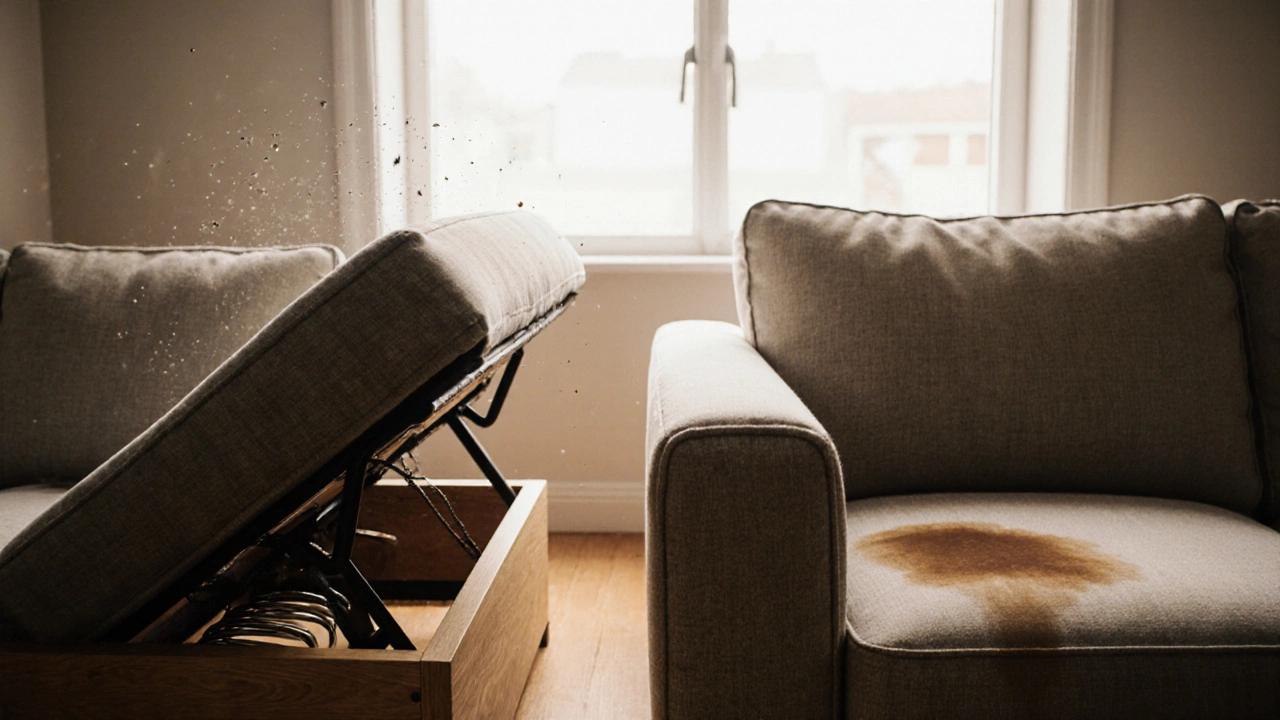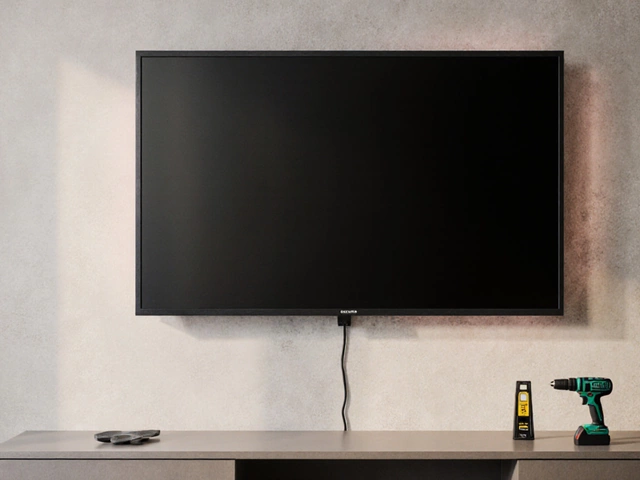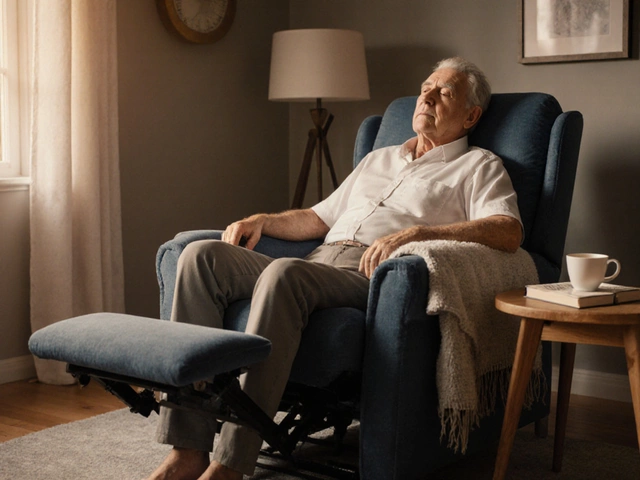Couch Cost Per Year Calculator
How Much Does Your Couch Really Cost Per Year?
See how the true cost of your couch compares to average models. Quality construction may cost more upfront but saves money long-term.
This calculator shows the true annual cost based on construction quality and expected lifespan.
The average couch lasts 7-10 years. High-quality models can last 15-25 years.
Everyone’s been there-you’re shopping for a new couch, and you see two side by side. One costs $800. The other, $3,000. You pause. Is that extra $2,200 really worth it? Or are you just paying for a fancy label? The truth isn’t as simple as ‘you get what you pay for.’ But it’s not a myth either. Expensive couches do last longer-but only if they’re built right. Not all high-priced couches are made equal, and not all cheap ones fall apart after a year.
What Makes a Couch Last?
A couch doesn’t last because it’s expensive. It lasts because of what’s inside. The frame, the springs, the cushion fill, the fabric-these are the real players. A $1,500 couch made with kiln-dried hardwood, eight-way hand-tied springs, and high-density foam can outlast a $3,500 couch made with particleboard, glued joints, and low-resilience foam.
Here’s what actually matters:
- Frame material: Hardwood (like oak, maple, or beech) lasts decades. Particleboard or plywood? Expect cracks and wobbles in 3-5 years.
- Joinery: Dovetail, mortise-and-tenon, or screwed-and-glued joints hold up. Nails and staples? They loosen over time.
- Springs: Eight-way hand-tied springs are the gold standard. Sinuous springs are fine for mid-range couches. Coil springs in cheap models sag fast.
- Cushion fill: High-density foam (2.5 lb/ft³ or higher) retains shape. Lower-density foam (under 1.8 lb/ft³) flattens in months. Down-blend cushions feel luxurious but need fluffing.
- Upholstery: Performance fabrics like Crypton, Sunbrella, or tightly woven polyester resist stains and wear. Cheap microfiber? It pills. Velvet? It crushes. Leather? It lasts-if it’s full-grain, not bonded.
These aren’t marketing buzzwords. They’re engineering specs. Brands that charge more usually list them. Brands that charge less? They don’t. That’s your first clue.
How Long Should a Couch Actually Last?
The average couch lasts 7 to 10 years. That’s what Consumer Reports found after testing over 1,200 models. But here’s the twist: the best-built couches last 15 to 25 years. And the worst? Some break down in under 3 years.
Think about it this way: if you buy a $600 couch that dies in 4 years, you spent $150 a year. A $2,400 couch that lasts 20 years? That’s $120 a year. The more expensive one saves you money over time-even if it costs more upfront.
But here’s the catch: you can’t assume price equals longevity. A $4,000 couch from a trendy online brand might use the same frame as a $1,000 one. The difference? The logo, the Instagram ad, and the free delivery. Real durability doesn’t come from packaging. It comes from construction.
What You’re Really Paying For
When you pay more for a couch, you’re paying for:
- Materials: Solid wood instead of MDF. Full-grain leather instead of vinyl. High-resilience foam instead of cheap polyurethane.
- Manufacturing: Handcrafted in the U.S. or Italy versus mass-produced in a factory with 12-second assembly lines.
- Warranty: A 10-year frame warranty is standard for premium brands. Budget brands offer 1 year. That’s not a coincidence.
- Customer service: Can you get replacement cushions? Fabric swatches? Repair kits? Premium brands usually offer them. Budget ones? Good luck.
- Design: Time-tested proportions, ergonomic depth, and armrest height that actually work for real bodies-not just photoshoots.
Some brands, like Stickley, Hancock & Moore, and Natuzzi, have been making the same couches for 100+ years. Their models haven’t changed because they don’t need to. They’re built to be repaired, not replaced.

When Expensive Doesn’t Mean Better
Not every expensive couch is worth it. Watch out for these traps:
- Designer labels: A couch with a famous name but no construction details? Red flag. Some brands just slap a name on imported frames.
- Too much leather: Full-grain leather is durable. But bonded leather? It’s just plastic-coated scraps. It cracks in 2-3 years. Don’t be fooled by the word “leather.”
- Overstuffed cushions: A couch that looks like a marshmallow might feel comfy at first-but it loses shape fast. Look for firm, supportive fills.
- Online-only brands: Many promise luxury but skip the testing. You can’t sit on it before you buy. No return policy? No warranty? That’s not a deal-it’s a gamble.
There are plenty of mid-range couches ($1,200-$1,800) that beat expensive ones. Brands like Floyd, Article, and Burrow use solid wood frames, high-density foam, and durable fabrics. They’re transparent about materials. They don’t charge for a logo.
How to Spot a Long-Lasting Couch (Even on a Budget)
You don’t need to spend $5,000 to get a couch that lasts. Here’s how to find one that will:
- Check the frame: Lift the couch. If it feels light, it’s probably made of particleboard. A heavy couch? Likely hardwood.
- Look under the cushions: Pull back the fabric. Can you see springs? Are they tied? Or just flat wires? Hand-tied springs mean quality.
- Press the arms and back: If you feel hard wood or metal underneath, that’s good. If it’s soft or squishy, it’s probably foam padding over cheap material.
- Ask for the warranty: A 10-year frame warranty is the bare minimum for a good couch. Anything less? You’re risking a short life.
- Read real reviews: Look for comments like “still looks new after 5 years” or “cushions flattened in 6 months.” Avoid reviews that just say “love it!” without details.
Visit a local furniture store. Sit on the couches. Ask the salesperson: “What’s the frame made of?” “Is the foam density listed?” “Do you offer replacement cushions?” If they hesitate or give vague answers, walk away.

Repair vs. Replace: The Smart Choice
One of the biggest myths is that you have to replace a couch when it starts to wear. That’s not true. A well-made couch can be reupholstered, re-stuffed, and re-sprung. A professional reupholstering job costs $800-$1,500. That’s less than half the price of a new high-end couch-and it keeps the frame alive.
Think of it like a car. You don’t buy a new one every time the tires wear out. You replace the tires. Same with your couch. If the frame is solid, it’s worth repairing. If the frame is flimsy? Then yes, replace it. But don’t assume the expensive one is the only one worth saving.
Bottom Line: It’s Not About Price. It’s About Build.
Expensive couches don’t automatically last longer. But couches built with real materials, solid frames, and honest craftsmanship? Those last. And they’re often worth the price-not because they’re flashy, but because they don’t need replacing.
Don’t buy based on brand names. Don’t buy based on color trends. Buy based on what’s inside. Ask the questions. Test the frame. Check the warranty. Look for durability, not decoration.
Your couch is one of the most used pieces of furniture in your home. It holds your family, your late-night movies, your spilled coffee, your dog’s naps. It deserves more than a bargain-bin frame.
Do expensive couches really last longer than cheap ones?
Not always. Some expensive couches are overpriced for their construction. But well-made, high-quality couches-whether they cost $1,500 or $4,000-typically last longer because they use solid hardwood frames, durable springs, and high-density foam. Price alone doesn’t guarantee longevity. Build quality does.
What’s the average lifespan of a sofa?
The average sofa lasts 7 to 10 years. But couches built with solid wood frames, hand-tied springs, and high-density foam can last 15 to 25 years. On the other end, low-quality couches with particleboard frames and thin foam often break down in 3 to 5 years.
Is it worth repairing a couch instead of replacing it?
Yes-if the frame is solid. Reupholstering, replacing cushions, or re-springing a couch costs $800-$1,500. That’s often less than buying a new one, especially a high-end model. If the frame is made of hardwood and still feels sturdy, repair is the smarter, more sustainable choice.
What fabric lasts the longest on a sofa?
Performance fabrics like Crypton, Sunbrella, and tightly woven polyester resist stains, fading, and wear. Full-grain leather is durable too, but only if it’s real-not bonded. Avoid cheap microfiber and velvet, which pill or crush easily. Look for a rub count (double rub test) of 30,000 or higher for heavy use.
How can I tell if a couch frame is good quality?
Lift the couch-if it’s heavy, it’s likely hardwood. Check under the cushions: you should see solid wood joints, not nails or staples. Look for dovetail or mortise-and-tenon construction. Avoid anything with particleboard, plywood, or visible glue. A 10-year warranty on the frame is a strong sign of confidence in quality.







